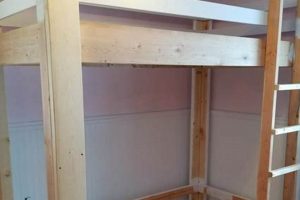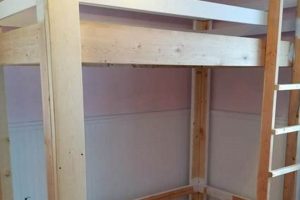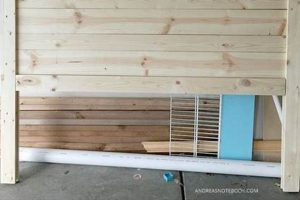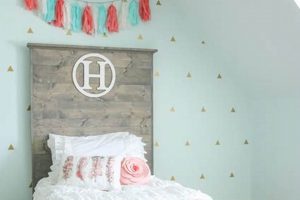A suspended sleeping or seating platform constructed by an individual is typically referred to as a self-made oscillating daybed. Such a structure combines the functionality of a bed with the relaxing motion of a swing, often intended for outdoor or indoor recreational use. A common illustration includes a repurposed crib mattress secured to a porch ceiling using rope and hardware, providing a comfortable, swaying resting area.
The appeal of building such a structure lies in its potential for cost savings, customization, and the satisfaction of creating a unique piece of furniture. Historically, similar suspended beds have been used in various cultures for comfort and relaxation. The modern iteration provides a personalized haven, adaptable to specific spatial requirements and aesthetic preferences, fostering a sense of tranquility and leisure.
Subsequent sections will explore the essential considerations for designing and building a stable and aesthetically pleasing example, including material selection, safety precautions, and construction techniques. Further discussion will elaborate on design variations, hardware options, and strategies for integrating the finished project into a variety of residential settings.
Construction Considerations
The following considerations are essential for the successful and safe construction of a suspended platform. Attention to detail throughout the building process is critical.
Tip 1: Material Selection: Choose lumber that is rated for exterior use, even for indoor projects, to ensure durability and resistance to moisture. Consider hardwoods like cedar or redwood for enhanced longevity. Pressure-treated lumber should be carefully considered for safety if contact is frequent.
Tip 2: Weight Capacity Assessment: Accurately calculate the maximum weight the structure will bear, including the weight of the frame, mattress, and occupants. The supporting structure, such as ceiling joists or porch rafters, must be capable of supporting at least four times this calculated weight.
Tip 3: Suspension Hardware Integrity: Utilize heavy-duty eye bolts, chains, or ropes specifically designed for hanging furniture. Confirm the weight rating of all hardware components and select items that exceed the anticipated load. Install eye bolts directly into structural framing members, never drywall or sheathing alone.
Tip 4: Secure Fastening Techniques: Employ appropriate fastening techniques for joining lumber components. Use screws or bolts rather than nails for superior strength and stability. Pre-drill pilot holes to prevent wood splitting, particularly when working with hardwoods.
Tip 5: Rope Selection and Knot Security: When using rope, select a high-strength synthetic fiber rope with a low stretch coefficient. Employ knots that are known for their secure holding power, such as a bowline or a figure-eight knot. Regularly inspect ropes for wear and replace them as needed.
Tip 6: Frame Reinforcement: Reinforce the frame’s corners and joints with metal brackets or by incorporating diagonal bracing. This measure will significantly enhance the structure’s rigidity and prevent sagging over time.
Tip 7: Spring Installation: Consider using springs for additional cushioning. Always install springs which is intended for the structure.
Diligent attention to these details ensures a safe, durable, and aesthetically pleasing structure. Adherence to safety guidelines throughout the construction process is paramount.
Subsequent discussions will address specific design considerations and customization options to enhance the comfort and appearance of the finished product.
1. Safety First
The principle of “Safety First” is not merely a guideline but a fundamental requirement in the construction of a self-made oscillating platform. The potential for injury due to structural failure necessitates meticulous planning, material selection, and execution.
- Load Capacity Assessment
Accurately determining the maximum load, encompassing the frame, bedding, and occupants, is paramount. Overestimation is prudent. This value dictates the selection of lumber, hardware, and hanging apparatus. Failure to accurately assess and accommodate the anticipated weight can lead to catastrophic structural collapse.
- Hanging Mechanism Integrity
The hanging mechanism chains, ropes, or a combination thereof forms the crucial link between the platform and its support structure. Employing components rated to withstand significantly more than the assessed maximum load is essential. Visual inspection for wear and tear before each use is a mandatory safety practice. Improper installation or use of substandard hardware introduces unacceptable risk.
- Structural Support Verification
The structural integrity of the supporting framework, be it ceiling joists or porch rafters, must be unequivocally confirmed. Consulting with a structural engineer or qualified contractor is advisable. Reinforcing existing structures may be necessary to ensure they can bear the static and dynamic forces imposed by the suspended platform. Neglecting this aspect jeopardizes the entire installation.
- Material Selection and Treatment
Employing weather-resistant lumber and treating all wood components with appropriate sealants is essential for longevity and safety. Rotting or decaying wood compromises structural integrity and poses a collapse hazard. Regular inspection and maintenance are required to identify and address any signs of deterioration.
The interrelation of load assessment, hanging mechanism, structural support, and material integrity dictates the overall safety profile of a homemade suspended platform. Rigorous adherence to these considerations minimizes the risk of injury and ensures the longevity and enjoyment of the finished project. Compromising on any aspect of safety invites potentially severe consequences.
2. Structural Integrity
The concept of structural integrity is paramount in the context of a self-constructed oscillating daybed. It directly determines the safety and longevity of the suspended platform. Deficiencies in structural design or execution can result in catastrophic failure, leading to potential injury. Therefore, understanding and prioritizing this aspect is non-negotiable.
The correlation between materials, joinery, and suspension mechanisms is a key element. For instance, using substandard lumber or inadequate fastening techniques creates weak points that compromise the entire structure. Similarly, improper weight distribution or an insufficient hanging system can overstress individual components, leading to gradual deformation or sudden breakage. A documented case involves a porch swing constructed with untreated pine and hung with lightweight chain; within a year, the wood had begun to rot and the chain failed, resulting in the swing collapsing under normal use. Such instances highlight the importance of selecting appropriate, load-bearing materials and robust hanging hardware. Correct installation techniques, such as properly spacing and securing eye bolts into structural joists, are also vital.
In conclusion, ensuring structural integrity is not merely an optional consideration, but a fundamental prerequisite for a safe and durable suspended platform. Diligence in material selection, construction methods, and weight distribution is essential. Failure to adequately address these factors directly compromises the structural soundness and user safety. The broader implications extend to code compliance in some jurisdictions, further underscoring the necessity of adherence to established engineering principles.
3. Material Durability
The selection of durable materials is paramount in the construction of a suspended daybed, directly influencing its longevity, safety, and overall value. Given its exposure to environmental elements and sustained weight-bearing requirements, compromising on material quality introduces significant risks of premature failure and potential injury.
- Wood Species Selection
The choice of wood species significantly impacts the structure’s resistance to rot, insect infestation, and weathering. Hardwoods such as cedar, redwood, or pressure-treated pine exhibit superior durability compared to softwoods like untreated pine or fir. Cedar, for instance, contains natural oils that act as preservatives, resisting moisture and insect damage. Conversely, untreated pine is susceptible to rapid degradation when exposed to the elements, requiring frequent maintenance and eventual replacement.
- Hardware Corrosion Resistance
Metal components, including chains, eye bolts, and fasteners, are vulnerable to corrosion, particularly in outdoor environments. Galvanized steel or stainless steel hardware offers enhanced resistance to rust and oxidation, ensuring the structural integrity of the suspension system over time. The use of standard steel hardware, lacking protective coatings, results in corrosion that weakens the connections and poses a safety hazard.
- Fabric and Upholstery Longevity
For upholstered portions of the platform, the selection of durable, weather-resistant fabrics is essential. Outdoor-rated fabrics, such as solution-dyed acrylics, exhibit superior resistance to fading, mildew, and water damage compared to standard cotton or linen. Prolonged exposure to sunlight and moisture causes rapid deterioration of unsuitable fabrics, compromising the aesthetic appeal and structural integrity of the upholstery.
- Protective Coatings and Sealants
Application of protective coatings and sealants enhances the durability of wood components, shielding them from moisture, ultraviolet radiation, and abrasion. Spar varnish or marine-grade sealants provide a durable, water-resistant barrier that extends the lifespan of the wood and minimizes the risk of rot and decay. Neglecting to apply protective coatings leaves the wood vulnerable to environmental damage, accelerating deterioration and requiring costly repairs or replacements.
The interplay between wood species, hardware composition, fabric selection, and protective coatings collectively determines the overall durability profile of the suspended platform. Prioritizing the use of resilient materials and applying appropriate protective measures ensures a safe, long-lasting structure capable of withstanding environmental stressors and prolonged use. This investment in material quality translates to reduced maintenance costs, enhanced safety, and extended service life of the completed project.
4. Hanging Method
The “hanging method” is critically linked to the success and safety of any self-constructed oscillating daybed. It is the direct interface between the suspended platform and the supporting structure, governing load transfer, stability, and user safety. A poorly executed hanging method invariably leads to structural instability, premature failure, and potential injury. The choice of hanging mechanism, including materials, configuration, and attachment points, significantly dictates the overall performance and lifespan of the project. For instance, using undersized chains or ropes not rated for the intended load can lead to catastrophic breakage, while improper knot tying or insecure hardware connections can result in gradual slippage and eventual collapse. Correctly assessing the load, selecting appropriate materials with verifiable ratings, and implementing sound engineering practices are essential elements of a reliable hanging method.
Practical application of this understanding involves careful consideration of factors such as weight distribution and swing dynamics. A hanging method that does not evenly distribute the load across multiple support points can create stress concentrations, weakening specific areas and accelerating material fatigue. Similarly, the geometry of the hanging configuration affects the smoothness of the swing motion and the stability of the platform during use. A common mistake is to hang a platform from a single point, which can result in excessive swaying and instability. A more effective approach is to use multiple suspension points, creating a stable and predictable swing path. This is often achieved through the use of triangular or rectangular hanging configurations, ensuring balanced load distribution and controlled movement. This should be coupled with using springs for a smoother ride.
In summary, the hanging method represents a vital engineering aspect. Challenges involve accurately calculating load capacities, selecting suitable hardware, and implementing secure attachment techniques. Adherence to established engineering principles and a meticulous approach to detail are critical. Overlooking this aspect of the oscillating daybed project undermines its structural integrity and compromises user safety, highlighting the indispensable nature of a well-executed hanging method to the success of any such undertaking.
5. Weight Distribution
In the context of a self-constructed oscillating platform, the term “weight distribution” refers to the uniform dispersal of the total load across all supporting elements of the structure. Improper weight distribution represents a critical safety hazard, potentially leading to structural failure and consequential injury. Uneven loading concentrates stress on specific components, exceeding their design capacity and accelerating material fatigue. This principle applies directly to the design and construction where the placement of occupants, the dimensions of the platform, and the configuration of the suspension system must be carefully considered to ensure balanced load transfer.
Practical implications of inadequate weight distribution include, for example, a platform constructed with a single central hanging point. While seemingly simple, this design concentrates the entire load on that single point, potentially overstressing the supporting joist or the hanging hardware. This results in a greater likelihood of the connection failing. Conversely, a platform suspended from multiple points with unequal spacing will experience uneven stress on the supporting ropes or chains, leading to differential stretching and potential instability. The solution typically involves distributing the weight evenly across multiple support points, using a symmetrical hanging configuration and ensuring that the platform itself is rigid enough to prevent localized sagging.
In summary, weight distribution is an essential element in ensuring the safety, longevity, and stability of a self-constructed oscillating platform. Meticulous planning and execution, considering material properties, load calculations, and symmetrical design principles, are crucial. This aspect cannot be overstated in achieving the desired functionality and preserving the structural integrity. This also emphasizes the importance of careful consideration when making such projects.
6. Comfort Design
The integration of comfort design principles is not merely an aesthetic consideration but a fundamental requirement for maximizing the utility and enjoyment of a self-constructed suspended daybed. A design that neglects ergonomic considerations and material comfort is unlikely to provide the intended relaxing and therapeutic experience.
- Ergonomic Dimensions and Support
The dimensions of the platform must accommodate the intended user population, providing adequate space for reclining or lounging comfortably. Insufficient depth or width can result in awkward postures and discomfort. Similarly, the internal support structure, whether a mattress or a network of webbing, must provide adequate support to prevent sagging and pressure points. For example, a platform with a thin, unsupportive mattress is likely to cause discomfort and back pain, negating the intended benefits of a relaxing suspended resting area.
- Material Tactility and Temperature Regulation
The tactile properties of the materials used in the construction directly influence the comfort level. Rough or abrasive surfaces can cause skin irritation, while materials that trap heat can lead to overheating and discomfort. Selecting smooth, breathable fabrics and incorporating ventilation features can enhance comfort, particularly in warm climates. An example would be selecting a canvas that is breathable, unlike a material that does not allow airflow, thus making the structure too warm.
- Motion and Suspension Dynamics
The smoothness and predictability of the swing motion are critical for promoting relaxation. Jerky or erratic movements can be jarring and uncomfortable. The design of the suspension system should minimize friction and allow for a gentle, controlled swaying motion. Careful selection of springs or bushings can dampen vibrations and enhance the overall comfort. The distance the structure hangs from the ground matters.
- Integration of Comfort Features
Additional features, such as armrests, backrests, and cushions, can further enhance the comfort of the suspended platform. The placement and design of these features should be carefully considered to optimize ergonomic support and promote relaxation. Adjustable features allow users to customize the platform to their individual preferences. Cushions are an integral addition to the comfort.
In summary, the integration of comfort design principles into the construction of a homemade suspended daybed is essential for realizing its full potential as a relaxing and therapeutic space. Attending to ergonomic dimensions, material tactility, motion dynamics, and supplemental features can greatly enhance the user experience, transforming the platform from a mere novelty into a functional and enjoyable piece of furniture. Therefore, any design should consider this as an element that leads to the success of the overall objective of diy swing bed.
7. Aesthetic Harmony
Aesthetic harmony, in the context of a self-constructed oscillating platform, denotes the cohesive integration of visual elements to achieve a pleasing and unified design that complements its surrounding environment. This is not merely a matter of superficial decoration, but a fundamental consideration that influences the perceived value, user experience, and long-term integration of the platform into its intended setting. A lack of aesthetic harmony can detract from the functionality of the structure. For example, a brightly colored swing bed using clashing patterns could undermine the relaxing purpose. Conversely, a well-designed structure will not only be visually appealing but will also enhance the overall ambiance of the space.
Achieving aesthetic harmony requires attention to several key factors. First, the design should align with the architectural style of the house or outdoor setting. A rustic swing bed constructed of reclaimed wood may be appropriate for a country-style porch, while a sleek, modern design with clean lines and minimalist upholstery would be more suitable for a contemporary patio. Second, the color palette should be carefully considered to complement the existing decor and create a sense of visual balance. The choice of fabrics, finishes, and hardware should reflect the overall design aesthetic and contribute to a cohesive look. Third, the scale and proportions of the platform should be appropriate for the space, avoiding overcrowding or imbalance. Attention to detail, such as the selection of decorative pillows, throws, and lighting, can further enhance the aesthetic harmony of the finished project. This ensures that the structure will be visually and functionally at its best.
In conclusion, aesthetic harmony is an indispensable component of a successful self-constructed oscillating platform. Careful attention to design coherence, material selection, color palettes, scale, and environmental setting ensures a visually pleasing and functionally appropriate result. This consideration enhances its overall value, long-term integration, and user satisfaction, transforming it from a mere structure into a harmonious element of its environment.
Frequently Asked Questions
The following section addresses common inquiries and misconceptions regarding the design, construction, and maintenance of user-built suspended daybeds. The information provided is intended for informational purposes only and does not substitute professional engineering advice.
Question 1: What are the primary safety concerns associated with a “diy swing bed”?
The most significant safety concerns involve structural integrity, load capacity, and secure suspension. Improperly constructed frames or inadequate hanging mechanisms can lead to collapse and injury. It is essential to accurately assess the weight load and utilize materials rated to exceed that load by a substantial margin. Regular inspection of all components is also a good measure.
Question 2: What type of lumber is most suitable for outdoor “diy swing bed” construction?
Pressure-treated lumber, cedar, or redwood are generally recommended for outdoor applications due to their resistance to rot, insect infestation, and weathering. Untreated lumber is susceptible to rapid deterioration and is not recommended for prolonged outdoor exposure.
Question 3: What are the best practices for ensuring proper weight distribution in a “diy swing bed”?
Proper weight distribution involves utilizing multiple suspension points, evenly spaced across the platform. The frame itself should be structurally rigid to prevent localized sagging. Ensuring that the supporting structure (e.g., ceiling joists) is adequately reinforced to handle the load is also crucial.
Question 4: How does one determine the appropriate size and dimensions for a “diy swing bed”?
The dimensions should be based on the intended use and the number of occupants it is designed to accommodate. Consider the available space and the desired level of comfort. Common dimensions range from twin-size to queen-size mattresses, but customized dimensions are also possible.
Question 5: What type of hardware is recommended for suspending a “diy swing bed”, and how should it be installed?
Heavy-duty eye bolts, chains, or ropes specifically designed for hanging furniture are recommended. Hardware should be rated to support several times the maximum anticipated load. Eye bolts should be securely fastened directly into structural framing members, not drywall or sheathing alone.
Question 6: What maintenance is required to ensure the long-term safety and stability of a “diy swing bed”?
Regular inspection of all components, including the frame, suspension system, and hardware, is essential. Look for signs of wear, corrosion, or damage. Tighten loose connections and replace any damaged parts immediately. Reapply protective coatings to the wood as needed to prevent rot and weathering.
The information provided in this section emphasizes the importance of careful planning, material selection, and construction techniques in ensuring the safety and longevity of a self-made oscillating platform. Consulting with qualified professionals is recommended when dealing with structural or safety-related concerns.
Subsequent sections will address legal and regulatory considerations associated with building structures.
DIY Swing Bed
The preceding exploration of constructing a self-made oscillating platform has underscored critical considerations, ranging from structural integrity and material durability to weight distribution and aesthetic harmony. Each facet necessitates meticulous planning, diligent execution, and a thorough understanding of fundamental engineering principles to ensure user safety and project longevity. The inherent complexities of such a project demand respect for established construction practices and a commitment to prioritizing structural soundness above all else.
Therefore, prospective builders must approach the construction of a diy swing bed with a clear understanding of the associated responsibilities and potential risks. Prioritizing safety, adhering to established guidelines, and seeking professional consultation when necessary will maximize the likelihood of a successful and enduring outcome. The decision to undertake such a project should not be taken lightly, but rather approached with diligence, foresight, and a commitment to uncompromising quality.







